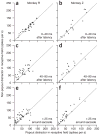LIP responses to a popout stimulus are reduced if it is overtly ignored
- PMID: 16819520
- PMCID: PMC2383314
- DOI: 10.1038/nn1734
LIP responses to a popout stimulus are reduced if it is overtly ignored
Abstract
Bright objects capture our attention by virtue of 'popping out' from their surroundings. This correlates with strong responses in cortical areas thought to be important in attentional allocation. Previous studies have suggested that with the right mindset or training, humans can ignore popout stimuli. We studied the activity of neurons in monkey lateral intraparietal area while monkeys performed a visual search task. The monkeys were free to move their eyes, and a distractor, but never the search target, popped out. On trials in which the monkeys made a saccade directly to the search target, the popout distractor evoked a smaller response than the non-popout distractors. The intensity of the response to the popout correlated inversely with the monkeys' ability to ignore it. We suggest that this modulation corresponds to a top-down mechanism that the brain uses to adjust the parietal representation of salience.
Figures





Comment in
-
Neurons that know when to quit.Nat Neurosci. 2006 Aug;9(8):984-5. doi: 10.1038/nn0806-984. Nat Neurosci. 2006. PMID: 16871161 No abstract available.
Similar articles
-
A pure salience response in posterior parietal cortex.Cereb Cortex. 2011 Nov;21(11):2498-506. doi: 10.1093/cercor/bhr035. Epub 2011 Mar 21. Cereb Cortex. 2011. PMID: 21422270 Free PMC article.
-
Frontal eye field activity before visual search errors reveals the integration of bottom-up and top-down salience.J Neurophysiol. 2005 Jan;93(1):337-51. doi: 10.1152/jn.00330.2004. Epub 2004 Aug 18. J Neurophysiol. 2005. PMID: 15317836 Free PMC article.
-
Temporal sequence of attentional modulation in the lateral intraparietal area and middle temporal area during rapid covert shifts of attention.J Neurosci. 2010 Mar 3;30(9):3287-96. doi: 10.1523/JNEUROSCI.6025-09.2010. J Neurosci. 2010. PMID: 20203188 Free PMC article.
-
Saccades, salience and attention: the role of the lateral intraparietal area in visual behavior.Prog Brain Res. 2006;155:157-75. doi: 10.1016/S0079-6123(06)55010-1. Prog Brain Res. 2006. PMID: 17027387 Free PMC article. Review.
-
Multimodal activity in the parietal cortex.Hear Res. 2009 Dec;258(1-2):100-5. doi: 10.1016/j.heares.2009.01.011. Epub 2009 Feb 6. Hear Res. 2009. PMID: 19450431 Free PMC article. Review.
Cited by
-
Cognitive functions of the posterior parietal cortex: top-down and bottom-up attentional control.Front Integr Neurosci. 2012 Jul 4;6:38. doi: 10.3389/fnint.2012.00038. eCollection 2012. Front Integr Neurosci. 2012. PMID: 22783174 Free PMC article.
-
Dissociable signatures of visual salience and behavioral relevance across attentional priority maps in human cortex.J Neurophysiol. 2018 Jun 1;119(6):2153-2165. doi: 10.1152/jn.00059.2018. Epub 2018 Feb 28. J Neurophysiol. 2018. PMID: 29488841 Free PMC article.
-
Extrafoveal preview benefit during free-viewing visual search in the monkey.J Vis. 2014 Jan 8;14(1):6. doi: 10.1167/14.1.6. J Vis. 2014. PMID: 24403392 Free PMC article.
-
Task specific computations in attentional maps.Vision Res. 2009 Jun;49(10):1216-26. doi: 10.1016/j.visres.2008.03.023. Epub 2008 May 27. Vision Res. 2009. PMID: 18502468 Free PMC article.
-
Neuroanatomical distinctions within the semantic system during sentence comprehension: evidence from functional magnetic resonance imaging.Neuroimage. 2008 Mar 1;40(1):367-88. doi: 10.1016/j.neuroimage.2007.10.009. Epub 2007 Oct 22. Neuroimage. 2008. PMID: 18248739 Free PMC article.
References
-
- Cave KR, Wolfe JM. Modeling the role of parallel processing in visual search. Cognit Psychol. 1990;22:225–271. - PubMed
-
- Duncan J, Humphreys GW. Visual search and stimulus similarity. Psychol Rev. 1989;96:433–458. - PubMed
-
- Treisman AM, Gelade G. A feature-integration theory of attention. Cognit Psychol. 1980;12:97–136. - PubMed
-
- Joseph JS, Optican LM. Involuntary attentional shifts due to orientation differences. Percept Psychophys. 1996;58:651–665. - PubMed
-
- Irwin DE, Colcombe AM, Kramer AF, Hahn S. Attentional and oculomotor capture by onset, luminance and color singletons. Vision Res. 2000;40:1443–1458. - PubMed
Publication types
MeSH terms
Grants and funding
LinkOut - more resources
Full Text Sources

